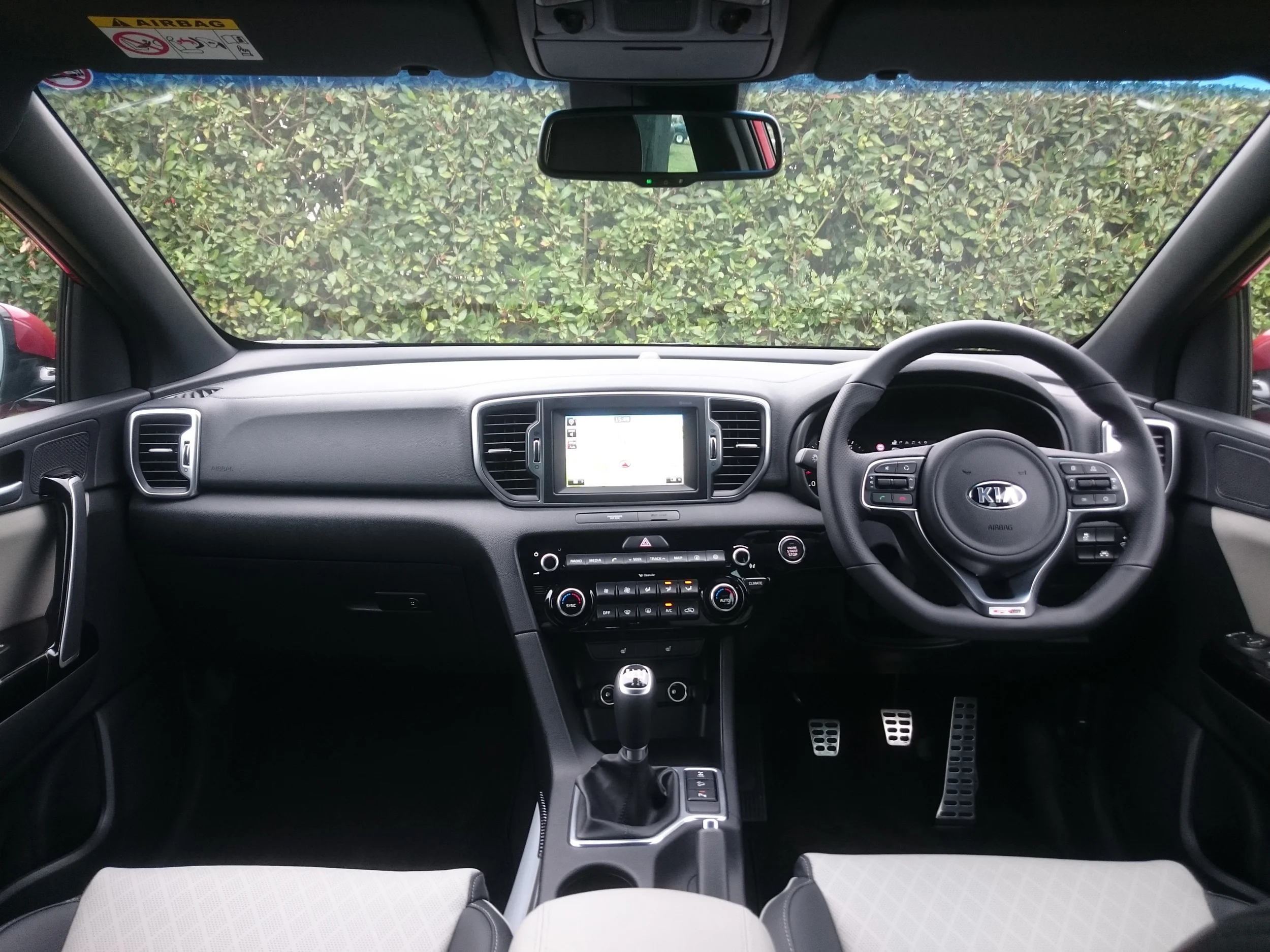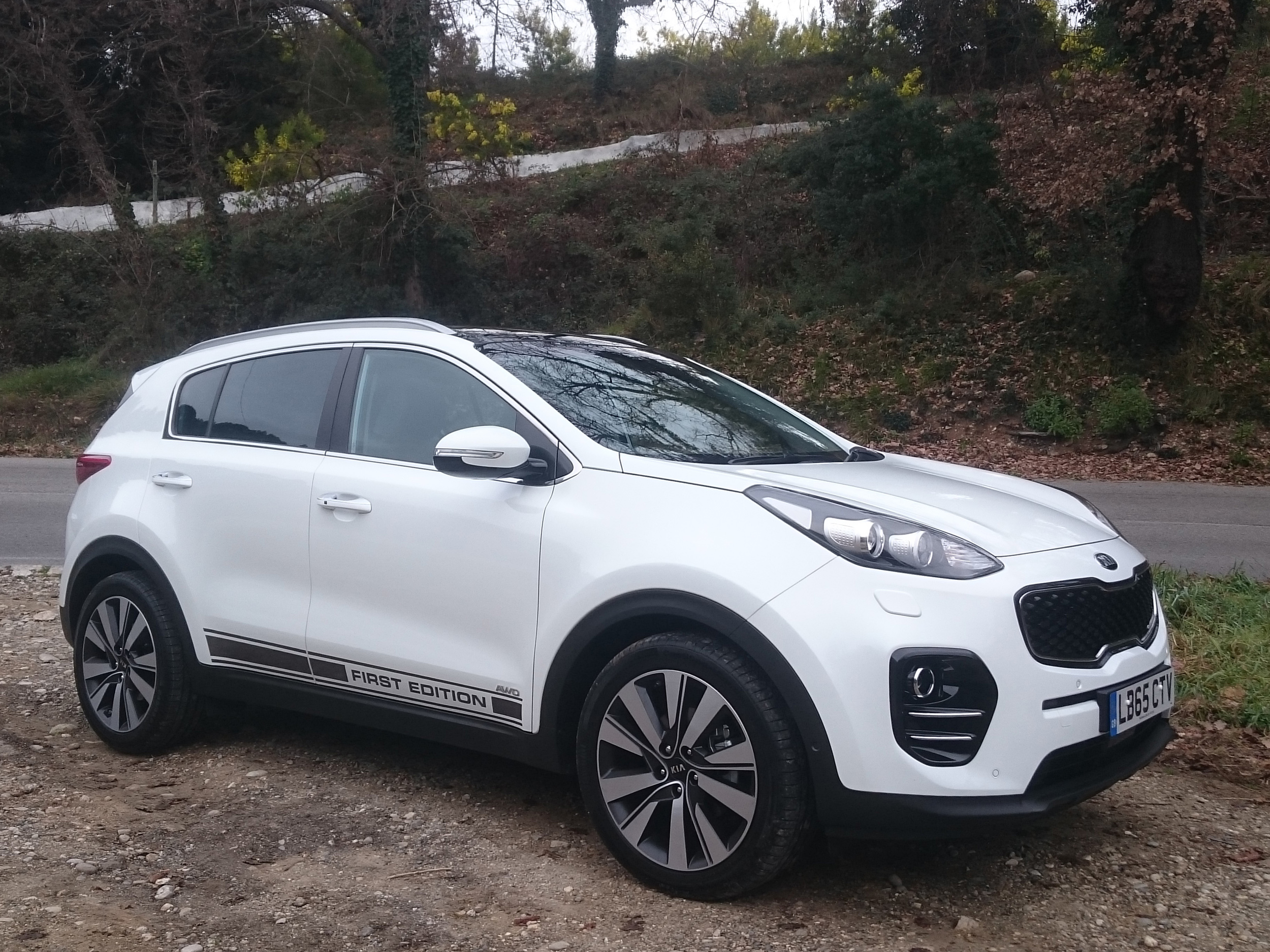






The all-new Sportage has a tough act to follow. Chris Pickering sees how the latest Kia measures up.
The previous generation Kia Sportage was one of the main models responsible for elevating the Korean brand from a budget option to a major contender in the mainstream market. It brought crisp lines from ex-Bentley, Lamborghini and Audi design director Peter Schreyer, along with vastly improved dynamics. Can the new model maintain that momentum?
We’ll get onto the details in a second, but the short answer is yes. It has another sharply styled Teutonic design, with more exuberantly sculpted flanks and a slightly more muscular physique. From some angles there’s even a hint of Porsche Cayenne about it.
Inside, there’s a rather curious stitching effect on the dash. At a quick glance it looks like leather, but on closer inspection it’s actually a soft-touch plastic. To our eyes this works quite well, but some may find it odd. Elsewhere, the lower trim grades do have some fairly large swathes of scratchy plastic, but that’s understandable at this price point. Overall, the cabin is attractive and well-finished.
There’s plenty of adjustment on both the seat and the steering wheel, with plentiful support for the back and shoulders. Rear seat passengers get a generous allowance of head and leg room too, not to mention reclining seats, 12-volt and USB sockets, plus a fold down centre armrest with their own pair of cupholders.
The Sportage’s boot is average for its class, but still pretty vast at 491 litres, extending to 1,480 litres if you fold the 60/40 split rear seats. There’s also a nice wide tailgate to aid loading, with no lip to speak of.
As befits the modern crossover, the new Sportage is available in both front-wheel drive and all-wheel drive versions. The latter is distinguished by a KX prefix in its trim spec, with regular models running from 1 (or KX-1) to 4 (KX-4). There’s also a sporty GT Line spec and a range-topping special edition to celebrate the car’s introduction known, originally enough, as the First Edition.
Prices start from £17,995 for the petrol 1.6 GDi 1 and range to £31,645 for the First Edition. This being Kia there are basically no option packs to worry about – you simply pick the grade that suits your wallet and requirements.
We didn’t have a chance to sample the base petrol, but that’s something of an irrelevance in a market where the vast majority of sales will be diesel. The 1.7 CRDi is likely to be the big seller, and not without reason. At 119 g/km of CO2 it’s road-tax free for the first year (although that’s set to change in 2017 with the new tax bands) and returns a claimed 61.4 mpg in front-wheel drive form.
It’s not the quickest crossover out there. The 114 bhp 1.7 CRDi takes 11.1 seconds to reach 60 mph, but it feels more than adequate for everyday use. Worked hard the engine becomes quite vocal, but it’s a reasonably melodic unit by diesel standards and it fades away to virtual silence once you’re up to speed.
Speaking of which, if you crave a bit more sport to your Sportage, the range-topping 182 bhp 2.0 CRDi engine provides a suitably vivid increase in performance. It’s only available in the KX-4 and the First Edition, but with a generous 400 Nm of torque it’s a big step on from the 1.7 CRDi. There’s also a 134 bhp version of the same engine, which promises to be a good compromise at 373 Nm of torque, with 139 g/km of CO2 and a claimed 54.3 mpg in front-wheel drive form.
Finally, there’s a turbocharged 1.6-litre petrol, available only in GT Line spec, which provides 174 bhp. In theory it’s the fastest of the bunch, but it has to be worked pretty hard to show any benefit over the torquier, greener and significantly more economical oil-burners. You’d have to be a fairly zealous diesel-hater to go for it.
All engines can be had with Kia’s crisp 6-speed manual, which is probably the best bet. The all-wheel drive 2-litre diesels come with the option of a smooth but rather slushy 6-speed automatic from KX-2 spec onwards. For the record, the 1.6 T-GDI GT Line also offers the option of a 7-speed dual clutch transmission.
On the road, the Sportage feels safe and secure rather than outright sporting. There’s no shortage of grip and it flows nicely, even on the bumpy, twisty tarmac of our French test route. The steering isn’t the last word in tactility, however, and there’s not a lot to goad you on. It’s better instead to enjoy the supple ride and decent levels of refinement.
The GT Line spec brings stiffer springs and dampers, plus retuned steering. You can sense the sharper responses through the chassis and they help to lend some substance to the sporty styling tweaks without compromising too much on ride, but it’s unlikely to satisfy anyone who’s secretly hankering after a hot hatch.
Equipment levels are generous right across the board. Even the base spec 1 (and KX-1) come with air conditioning and cruise control, plus a DAB radio and Bluetooth with voice recognition and music streaming. Hill Descent Control, Hill Start Assist and Trailer Stability Assist also come as standard. From 2 and above, all models feature a touchscreen infotainment system, complete with sat nav, live traffic updates and a reversing camera.
The third trim spec (3/KX-3) adds heated leather seats, high-gloss cabin trim and a very effective premium sound system from JBL. Between grades 2 and 3 comes the GT Line, which features 19-inch alloys and LED front fog lights. It also borrows the 4.2-inch LCD TFT instrument display from the 3, along with various uprated cabin materials.
Top spec models receive bi-xenon headlights, keyless start, plus a host of electronic safety systems. The 4/KX-4 gets Autonomous Emergency Braking and Blind Spot Detection with Rear Cross Traffic Alert, while the First Edition adds Kia’s intuitive Smart Parking Assist system, a smart powered tailgate, a wireless mobile phone charger and metallic paint. Phew.
Kia’s recent success means that residual values are predicted to be good. The new Sportage also comes with a five star Euro NCAP safety rating and the Korean brand’s unique seven year or 100,000 mile transferable warranty. It may not be the huge leap on that its predecessor was, but neither does it need to be. This deserves to be another strong seller.
